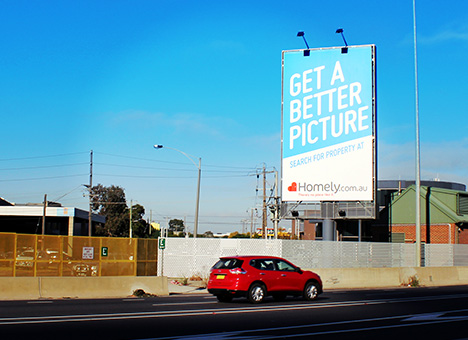Advertising trends are always changing, with new ways to reach people coming up all the time. However, one timeless marketing strategy that remains effective is outdoor advertising. From giant billboards to eye-catching transit ads, outdoor ads dominate public spaces and grab attention like no other medium.
But why is outdoor advertising still crucial, and how can businesses leverage it to amplify their brand presence?
In this blog, we have highlighted everything you need to know about outdoor advertising, its types, benefits, and its growing relevance in the modern marketing landscape.
What Is Outdoor Advertising?
Outdoor advertising refers to promotional displays located in public spaces to engage audiences who are on the go. Also known as out-of-home advertising, this medium includes any advertising formats visible outside of a consumer’s home. It serves as a bridge between businesses and their audience in real-world environments, making it an essential tool for creating brand visibility.
Key characteristics of outdoor advertising include:
- High visibility: Ads are strategically placed in high-traffic areas to ensure maximum exposure.
- Non-intrusive: Unlike digital ads, outdoor advertising doesn’t interrupt the audience’s activities.
- Continuous exposure: Outdoor ads are visible 24/7, providing constant engagement opportunities.
Outdoor advertising is distinct from other digital or print advertising methods because it targets consumers in physical and public settings, often leveraging the environment to amplify its message.
Types of Outdoor Advertising
Outdoor advertising comes in various forms, catering to diverse marketing goals. Here are some of the most common types:
1. Billboards
Billboards are perhaps the most iconic form of outdoor advertising. Found along highways, urban centres, and busy intersections, billboards deliver bold, large-scale messages that are hard to miss. They’re ideal for creating strong visual impressions.
2. Posters
Posters are smaller, more localised outdoor ads often placed on walls, inside shops, or in community spaces. They are cost-effective and perfect for targeting specific neighbourhoods or demographics.
3. Transit Advertising
Transit advertising includes ads on buses, trains, taxis, and even subways. These ads move with the vehicle, reaching a broad audience in urban and suburban areas.
4. Street Furniture
Street furniture advertising involves displaying promotional materials on public structures like bus shelters, benches, and kiosks. This type of advertising engages commuters and pedestrians.
5. Point of Sale Displays
Point of sale (POS) displays are placed in retail settings to encourage impulse purchases. These ads often highlight promotions, discounts, or new products.
6. Guerrilla Advertising
Guerrilla advertising uses a creative and unconventional approach to capture attention. Examples include 3D installations, graffiti art, and flash mobs, which make this type of advertising memorable and shareable on social media.
Digital Outdoor Advertising
In recent years, outdoor ads have gone through a complete digital transformation. Digital outdoor advertising uses advanced technology, such as LED screens, interactive kiosks, and augmented reality, to enhance traditional outdoor displays. This evolution offers marketers new ways to engage audiences dynamically and in real time.
Examples of Digital Outdoor Advertising:
- Digital billboards: High-resolution screens that display rotating ads for multiple brands.
- LED displays: Bright and colourful signage ideal for urban centres and nighttime visibility.
- Interactive kiosks: Touchscreen displays providing personalised experiences or additional product information.
Benefits of Digital Outdoor Advertising:
- Flexibility: Advertisers can update campaigns in real time to reflect new offers or changing circumstances.
- Engagement: Interactive features encourage direct consumer participation.
- Sustainability: Digital formats reduce paper waste and provide eco-friendly solutions.
- Enhanced targeting: Data-driven technologies allow for time-specific and location-specific ad placements.
Why Is Outdoor Advertising Important?
Outdoor advertising remains relevant in today’s marketing ecosystem due to its unmatched ability to connect with audiences in the real world. Here are some reasons why it is important:
1. Branding Opportunities
Outdoor ads help establish brand identity by creating lasting visual impressions. Repeated exposure to a brand’s logo, colours, or message reinforces recognition and recall.
2. Creating a Lasting Impact
Unlike fleeting online ads, out-of-home advertising is designed to leave a long-lasting impression. Bold visuals and creative storytelling resonate with audiences, making the brand memorable.
3. Reaching Mass Audiences
Outdoor advertising reaches diverse groups of people as they commute, shop, or engage in leisure activities. It’s a cost-effective way to reach a large audience base.
4. Complementing Other Media Channels
When integrated with digital or TV campaigns, outdoor advertising boosts overall reach and reinforces brand messaging across multiple touchpoints.
Benefits of Outdoor Advertising
Out-of-home advertising offers countless advantages that set it apart from other marketing strategies:
1. Cost-Effectiveness
Outdoor advertising is a budget-friendly option compared to TV or digital campaigns, especially for long-term promotions. A single billboard or poster can provide constant exposure for weeks or months without additional costs, offering excellent value for money. Small businesses, in particular, can benefit from the affordability of posters or localised transit ads.
2. High Visibility
Strategically placed outdoor ads can reach thousands, if not millions, of viewers daily. Positioned in high-traffic areas like highways, city centres, or public transit hubs, they ensure that your brand gains maximum exposure. This visibility reinforces brand recognition and keeps your business memorable.
3. Encouraging Impulse Decisions
Outdoor ads are particularly effective in driving on-the-spot decisions. For instance, a billboard promoting a nearby restaurant or store can prompt passersby to make immediate purchases. Their ability to influence consumer behaviour makes outdoor advertising a powerful tool for the retail and hospitality industries.
4. Long-Term Exposure
Unlike digital ads, which often disappear after a few seconds, outdoor advertisements stay in place for extended periods. This longevity ensures repeated exposure, helping consumers become familiar with your brand over time. Such constant visibility builds trust and enhances customer loyalty.
Tips for Effective Outdoor Advertising
To create effective outdoor advertising campaigns, marketers need to follow these best practices:
1. Design Principles for Better Visibility
- Use bold and vibrant colours to catch attention.
- Keep the text concise for quick readability.
- Incorporate striking visuals or logos that enhance brand recall.
2. Choosing the Right Locations
Select high-traffic areas that align with your target demographic. For example, ads targeting young professionals may perform well near business districts or metro stations.
3. Optimising Timing for Campaigns
Timing is crucial. Schedule campaigns during peak seasons or when your product or service is most in demand.
4. Legal Compliance and Permits
Ensure compliance with local regulations regarding outdoor ad placements. Obtain necessary permits to avoid legal complications.
Conclusion
Outdoor advertising remains one of the most important aspects of modern marketing due to its unparalleled ability to engage mass audiences and create lasting brand impressions. From traditional billboards to advanced digital displays, this medium offers businesses diverse ways to communicate their message. Whether you’re looking to build brand awareness or drive immediate sales, outdoor advertising provides countless opportunities for visibility and engagement.
Understanding the types, benefits, and strategies behind outdoor advertising in Australia can help businesses make informed decisions to maximise their marketing impact. In cities and urban spaces that offer unique advertising landscapes, outdoor ads will keep thriving as a powerful tool for connecting with audiences in the real world.
Contact The Media Planning Agency to take your brand forward and achieve your marketing goals with outdoor advertising. Call 1300 889 115 today.
FAQs
What are some examples of outdoor advertising?
Examples include billboards, transit ads on buses and trains, posters in shopping centres, and digital kiosks.
How effective is outdoor advertising?
Outdoor advertising is highly effective for increasing brand visibility, reaching diverse audiences, and driving customer action, especially when integrated with other media.
What are the costs involved in outdoor advertising?
Ad costs vary depending on factors such as ad size, location, duration, and whether the ad is traditional or digital. For instance, digital billboards in high-traffic areas typically cost more than static posters.
What is outdoor advertising also known as?
Outdoor advertising is also referred to as out-of-home advertising (OOH).



